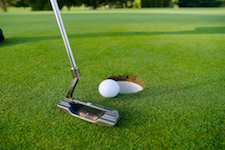HOLE 2:
GOLF EQUIPMENT
As a new golfer, it’s not necessary run out and buy a set of clubs the night before your first lesson nor is it wise to practice with your husband's hand-me-downs. Golf equipment is designed with skill and body size in mind, so it’s important to match clubs to your ability. And while golf requires a short list of necessary equipment, tempting extras, advances in technology and a wide range of price points can quickly make things confusing. In this section, you’ll learn which clubs you need, whether to rent or buy, what you’ll need for lessons and what to pack in your golf bag so you're prepared for the golf course.
GOLF CLUB BASICS
Introduction
Golf clubs are available in every shape and size and for many situations, skill levels, and types of shots. The combination of clubs you need is up to you, however the maximum number of golf clubs you may carry in your bag during tournament play may not exceed 14.
Club manufacturers offer a wide variety of technical configurations that help new golfers get the ball airborne and seasoned golfers execute specific shots. Golf clubs generally fall into four categories - woods, irons, wedges and putters - which are intended for different shots and situations on the course.
Anatomy of a Golf Club
You will hear about the different parts of a club when you take lessons and shop for your first set.
GRIP – The top part of the golf club that you hold with your hands to make a swing. Grips can be sized to fit your hands, and they come in differing degrees of "tackiness" for a firm hold on the club.
SHAFT – The "stem" of the club that connects the grip to the club head.
CLUB HEAD – The part of the club used to strike the ball.
HOSEL– The connection between the shaft and club head.
CLUB FACE – The flat part of the club head that is used to make contact with the ball.
SOLE – The bottom of the club head that rests on the ground.
TOE – The outer most part of the club face.
HEEL – The inner most part of the club face.
SWEET SPOT – The center of the club face that is the ideal place to strike the ball.
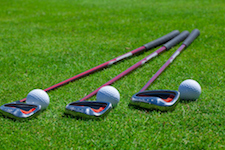


Golf Club Loft
Every golf club has a LOFT, which refers to the angle of the club face. This angle, or DEGREE OF LOFT, determines the flight height and path of the ball. The greater the loft, the higher the ball will travel into the air and the shorter distance it will travel. Conversely, less lofted clubs are designed to take a straighter path and go longer distances. For example, a 9 iron has a greater degree of loft and goes higher and a shorter distance, while a 4 iron has a lower degree of loft would goes lower and longer.
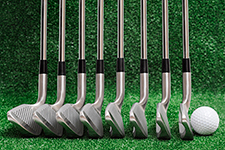


Club Shaft Equals Flight Distance
Club shafts come in different lengths and stiffness. The length of the shaft generally determines the distance the ball will travel. The longer the club shaft, the farther the ball travels. The shorter the shaft, the shorter the ball travels. The stiffness and weight of the shaft is a function of the material used in the construction of the club. You will hear people refer to GRAPHITE and STEEL shafts. The type of shaft is determined by how fast someone swings the club. Slower swing speeds do better with softer, lighter and more flexible shafts (graphite), while higher swing speeds perform better with a stiffer shaft (steel).
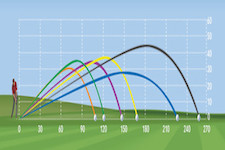


Types of Golf Clubs
DRIVER & WOODS
These are the power clubs of the game, designed for longer distances. Historically, club heads were made of wood, but over time the materials have transitioned to metal and high-tech materials that obtain maximum distance. Woods are identified by number, starting with the driver (also called the 1-wood), and follow in sequence to go progressively shorter distances.
The driver has the lowest loft and typically the largest club head. This club is designed to hit the ball off a tee and drive it far down the fairway. In regulation golf, a tee is only allowed in the tee areas, and therefore drivers are only used here as well. FAIRWAY WOODS are designed to travel long distances as well. Fairway woods can be used to hit a ball off a tee in the tee box area or off the ground on the fairway or rough.
Golfers generally carry a driver and a few woods, such as a 3-wood, 5-wood, 7-wood and 9-wood, in their golf bag.
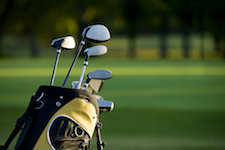


IRONS
Irons are generally used when you are getting closer to the green. The higher the number, the higher the loft and shorter the distance.
Golfers generally carry set of irons: 5-iron, 6-iron, 7-iron, 8-iron and 9-iron.
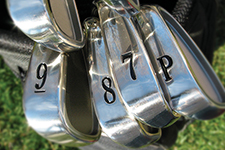


HYBRIDS
Hybrid clubs have become increasingly popular, as they combine characteristics of woods and irons. The club head resembles a smaller wood, which allows for distance while making it easier to make solid contact in a variety of conditions. You may hear golfers refer to hybrids as their RESCUE CLUB for this reason. Hybrids are also identified by number; the lower numbers go longer distances then higher numbers.
Golfers generally include a hybrid or two in their bag.
WEDGES
Wedges are the most lofted clubs in the bag and are used to get over obstacles and often land the ball on the green. They are also used for shorter distance "chip" and "pitch" shots when a full swing is too much distance. Wedges pick up where the 9-iron leaves off in terms of going shorter distances. Wedges are commonly marked with a letter and referred to as APPROACH (A), PITCH (P) and SAND (S) WEDGE or by its degree of loft (48, 52, 56, 60 and 64 - the higher numbers going shorter distances).
Golfers generally carry a pitch wedge (P) and sand wedge (S).
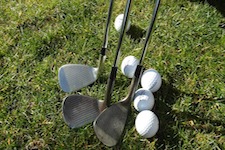


PUTTERS
The putter may be the most widely used club in the bag, as it is the only club allowed on the green. It is also the only club designed to keep the ball on the ground. Putters come with a variety of club heads, ranging from a single blade to a mallet shape, as well as a variety of shaft lengths.
Golfers generally need one putter, but it's not uncommon to carry two different types.
